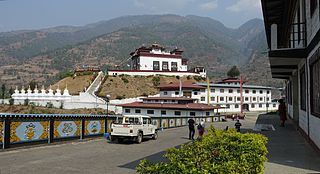
Thimphu is the capital and largest city of the Kingdom of Bhutan. It is situated in the western central part of Bhutan, and the surrounding valley is one of Bhutan's dzongkhags, the Thimphu District. The ancient capital city of Punakha was replaced as capital by Thimphu in 1955, and in 1961 Thimphu was declared as the capital of the Kingdom of Bhutan by His Majesty the 3rd Druk Gyalpo Jigme Dorji Wangchuck.
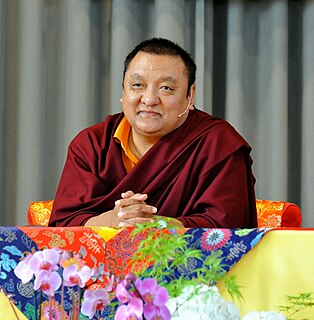
The Shamarpa, also known as Shamar Rinpoche, or more formally Künzig Shamar Rinpoche, is a lineage holder of the Karma Kagyu school of Tibetan Buddhism and is regarded to be the mind manifestation of Amitābha. He is traditionally associated with Yangpachen Monastery near Lhasa.
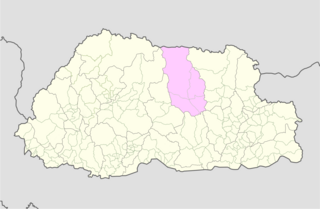
Bumthang District is one of the 20 dzongkhag (districts) comprising Bhutan. It is the most historic dzongkhag if the number of ancient temples and sacred sites is counted. Bumthang consists of the four mountain valleys of Ura, Chumey, Tang and Choekhor ("Bumthang"), although occasionally the entire district is referred to as Bumthang valley.

Chöje Akong Tulku Rinpoche was a tulku in the Kagyu school of Tibetan Buddhism and a founder of the Samye Ling Monastery in Scotland.

The sixteenth Gyalwa Karmapa, Rangjung Rigpe Dorje was spiritual leader of the Karma Kagyu lineage of Tibetan Buddhism. He was born in Denkhok in the Dergé district of Kham, near the Dri Chu or Yangtze River.

Svayambhu (स्वयम्भू) is a Sanskrit word that means "self-manifested", "self-existing", or "that is created by its own accord". In Tibetan, this word appears as "Rangjung" རང་བྱུང་.

Palpung Monastery is the name of the congregation of monasteries and centers of the Tai Situpa lineage of the Kagyu school of Tibetan Buddhism as well as the name of the Tai Situ's monastic seat in Derge, Kham. Palpung means "glorious union of study and practice". It originated in the 12th century and wielded considerable religious and political influence over the centuries.
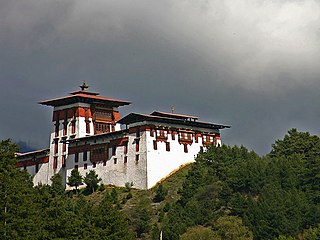
Jakar, also officially referred to as Bumthang, is a town in the central-eastern region of Bhutan. It is the district capital of Bumthang District and the location of Jakar Dzong, the regional dzong fortress. The name Jakar roughly translates as "white bird" in reference to its foundation myth, according to which a roosting white bird signaled the proper and auspicious location to found a monastery around 1549.
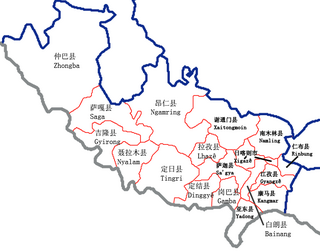
Namling County is a county of Shigatse in the Tibet Autonomous Region.
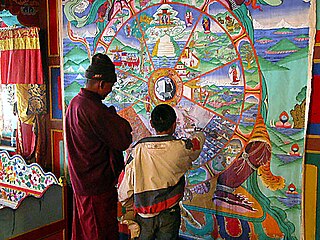
Shedra is a Tibetan word meaning "place of teaching" but specifically refers to the educational program in Tibetan Buddhist monasteries and nunneries. It is usually attended by monks and nuns between their early teen years and early twenties. Not all young monastics enter a shedra; some study ritual practices instead. Shedra is variously described as a university, monastic college, or philosophy school. The age range of students typically corresponds to both secondary school and college. After completing a shedra, some monks continue with further scholastic training toward a Khenpo or Geshe degree, and other monks pursue training in ritual practices.

Dramitse is a town in Drametse Gewog in the east part of Mongar District, Eastern Bhutan. At the 2005 census, its population was 541. It is situated on a hill opposite the town of Tashigang.
Orgyen Tobgyal Rinpoche, also called Tulku Ugyen Topgyal, is a Tibetan Buddhist lama who was born in Kham in Eastern Tibet in 1951, living in exile in India.

Garzê or Gānzī, is a town and county seat in Garzê County, Garzê Tibetan Autonomous Prefecture in western Sichuan Province, China. Despite Garzê Prefecture being named after the town, the prefecture capital is actually Kangding, 365 km to the southeast. As of 2010, Garzê was home to 16,920 inhabitants. Garzê is an ethnic Tibetan township and is located in the historical Tibetan region of Kham. It contains the 15th century Kandze Monastery, home to over 500 Gelugpa monks.
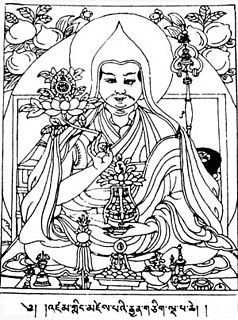
The Dual System of Government is the traditional diarchal political system of Tibetan peoples whereby the Desi coexists with the spiritual authority of the realm, usually unified under a third single ruler. The actual distribution of power between institutions varied over time and location. The Tibetan term Cho-sid-nyi literally means "both Dharma and temporal," but may also be translated as "dual system of religion and politics."

The Dratshang Lhentshog is the Commission for the Monastic Affairs of Bhutan. Under the 2008 Constitution, it is the bureaucracy that oversees the Drukpa Kagyu sect that is the state religion of Bhutan. Although Bhutan has a state religion, the role of the religious bureaucracy ideally complements secular institutions within a dual system of government.
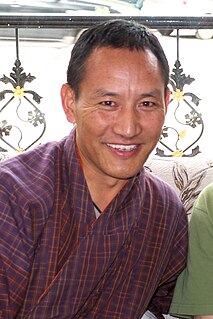
Lopen Karma Phuntsho was born in Ura gewog in Bumthang district of central Bhutan. He was born as the third child of Tothchukpo House to his mother who is a scion of Gaden Lam family which traces its origin to Phajo Drukgom Zhigpo, the priest who brought Drukpa Kagyu tradition of Tibetan Buddhism to western Bhutan. Karma learnt basic Chokey alphabets and prayers from his father, who is an incarnate priest and farmer from the Tsakaling Choje family, a religious nobility which claims descent from Bhutan's foremost spiritual saint Pema Lingpa and Tarshong Chukpo house of Ura. He attended Ura Primary School until Class III. Because the school did not have Class IV and he was too small to travel, his parents begged the headmaster to keep him in Ura and repeat. The following year, he travelled to Jakar School with a few friends. The headmaster at the new school mistakenly put Karma again in Class III. Karma today humorously claims that he is perhaps the only person who studied in Class III for three years and received first prizes thrice. Karma spent most of his school winter breaks helping the family cow herder in the neighbouring district of Lhuntse.
Tsikey Chokling Rinpoche is a teacher, writer, religious ritual master, and meditation master of the Nyingma school of Tibetan Buddhism.



